The foundation of credibility in wine writing is the willingness to clearly criticize shortcomings in a wine or a winery or a region. Anybody can lavish praise upon delicious wines and brilliant winemakers. But at some point, this starts to wear thin. We live in a world where the sun doesn't always shine, and a weather forecaster who is continually optimistic is useless to us. So too is a wine writer who loves everything he tastes, and who thinks every winegrowing region is filled with geniuses.
I have a lot to say in praise of Rioja in this column, but for the sake of credibility, want to note as my point of departure that 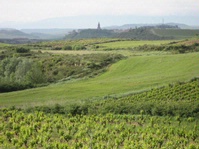 almost everything I have published about the region during the past 15 years has been critical. In my view, Rioja has let other Spanish regions steal its thunder due to a complacent sense of entitlement.
almost everything I have published about the region during the past 15 years has been critical. In my view, Rioja has let other Spanish regions steal its thunder due to a complacent sense of entitlement.
As other regions were questioning their traditions and straining to achieve greatness during the past two decades, Rioja tended to rest on its laurels. As the rest of Spain redoubled its efforts to improve fruit quality in vineyards, Rioja remained overly reliant on its barrels for character and complexity. With an aristocrat's disdain for the upstarts nipping at its heels, Rioja failed to maintain its historic position of leadership in Spanish red wine.
Then, when Rioja finally got the message that the worldwide buzz about Spain was all about Priorat, Ribera del Duero, Rias Baixas and Toro, it freaked out and over-reacted. Many producers devoted their energies to producing "high-expression" flagship wines that would be as dark and dense as wines from warmer regions, and sought to outdo one another in how heavy they could make their bottles and how high they could raise their prices.
Many of these wines were actually quite impressive, but they represented only a tiny fraction of total production, and did nothing to address the fact that Rioja's bread-and-butter wines (Crianzas and Reservas) were taking a beating from fresher, purer, richer wines from Ribera del Duero, Toro, Monstant and other regions on the rise.
In my opinion, the emphasis on 'high-expression' wines in the late 1990s was a bit like responding to a dog attacking one's leg by straightening one's necktie.
I understand, of course, that these criticisms are debatable, if only on the obvious ground that I am generalizing about a region with more than 500 producers, the best of whom are quite innocent of the foregoing charges. Nevertheless, generalizations are necessary to speak meaningfully about regions as a whole, and consumers around the world think first about whole regions rather than individual bodegas. And I believe that my account of Rioja's fall from indisputable primacy in the mid-1980s gets the essentials right.
The point of this, however, is not to recount an unfortunate phase from Rioja's past, but rather to set a credible foundation for predicting its impending resurgence.
I spent all of last week tasting and talking with producers in Rioja, 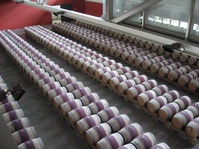 and was greatly encouraged by what I tasted and heard. I sensed rumblings of resurgence when tasting there for a week in 2004, though that trip still suggested that the region was in widespread disarray. Some producers were stuck in denial about the outmoded nature of wines that strike the rest of the world as thin, over-oaked, and oxidized. Others had cut bait entirely on tradition, achieving greater freshness and depth of flavor, but doing so at the cost of the spicy, leathery complexities that have made Rioja distinctive for over a century.
and was greatly encouraged by what I tasted and heard. I sensed rumblings of resurgence when tasting there for a week in 2004, though that trip still suggested that the region was in widespread disarray. Some producers were stuck in denial about the outmoded nature of wines that strike the rest of the world as thin, over-oaked, and oxidized. Others had cut bait entirely on tradition, achieving greater freshness and depth of flavor, but doing so at the cost of the spicy, leathery complexities that have made Rioja distinctive for over a century.
By contrast, on this most recent trip my sense was that many 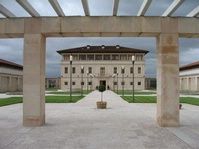 producers have now settled onto a moderate and reasonable middle ground in stylistic terms. The Crianzas from 2004 and 2005 were notably more restrained in terms of oak--on average--than were their counterparts from, say, 1998 and 1999 at a comparable stage of development. This was also true of the Reservas from 2003 and 2004 by comparison to earlier renditions.
producers have now settled onto a moderate and reasonable middle ground in stylistic terms. The Crianzas from 2004 and 2005 were notably more restrained in terms of oak--on average--than were their counterparts from, say, 1998 and 1999 at a comparable stage of development. This was also true of the Reservas from 2003 and 2004 by comparison to earlier renditions.
In terms of ripeness and weight, the current release wines were a little plumper and fruitier than those of the past, but didn't show a chunky character or over-ripe notes that I saw in some wines four years ago. My sense is that a consensus is emerging to the effect that Rioja's wines need to be somewhat riper and more concentrated than has been the norm since the 1970s if they are to hold their own in the contemporary world market. However, I also get the sense that Rioja producers have come to terms with the fact that their wines will--if ripened in a balanced way--remain lighter than Ribera del Duero or Toro wines, and will have to compete on grounds of complexity rather than sheer power.
One wonders if the current boom enjoyed by Pinot Noir has helped Rioja producers recognize that consumers will not dismiss non-blockbuster wines out of hand. Be that as it may, the emerging consensus seems to favor a style that is riper and more concentrated than Riojas of the past, but not dramatically so, with oak that lends spiciness and grip, but doesn't overwhelm the wine's fruit or dry out its finish.
To my way of thinking, this is exactly the right approach to making Rioja that will appeal to consumers in today's global market, but do so without abandoning tradition outright or asking more of Rioja's climate and grape varieties than they can reliably deliver.
An interesting sidelight that supports this notion is that the fervor once seen in the region for Cabernet Sauvignon, Merlot and Syrah as supplementary varieties seems to have waned notably, whereas interest in using Graciano instead for bolstering the structure of Tempranillo is clearly waxing. This variety is very much in demand, commanding high prices on the open market that are--in turn--spurring new plantings.
Looking ahead, Rioja has a slew of strengths that make a major 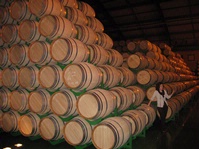 resurgence very likely. Among these, the sheer size of the region and many of its producers is an important factor. Considering Spanish wine production overall, Rioja has far more than its share of large bodegas, and these enjoy economies of scale that translate into strong competitive advantages. A bodega like Juan Alcorta that is sitting on 70,000 barrels of wine and 6 million bottles has much more room to maneuver in terms of pricing strategy than small producers in Toro or Priorat. They can afford to take a smaller profit on each sale, building market share while still making money.
resurgence very likely. Among these, the sheer size of the region and many of its producers is an important factor. Considering Spanish wine production overall, Rioja has far more than its share of large bodegas, and these enjoy economies of scale that translate into strong competitive advantages. A bodega like Juan Alcorta that is sitting on 70,000 barrels of wine and 6 million bottles has much more room to maneuver in terms of pricing strategy than small producers in Toro or Priorat. They can afford to take a smaller profit on each sale, building market share while still making money.
Big bodegas are also much better able to wait out fluctuations in international currency exchange rates than are small producers. And in terms of market penetration, name recognition, and general promotion, Rioja benefits significantly from its sheer size. Ribera del Duero is a big region, with 49,420 acres planted to vines. But it is dwarfed by Rioja, which has 148,260 acres, and makes more than three times as much wine.
Also significant among Rioja's strengths are several factors 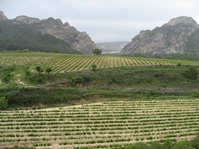 extending beyond wine itself. One important asset is the region's natural beauty, which makes it extremely attractive as a destination for tourists--wine loving or otherwise. Set against the backdrop of the jagged, dramatic Cantabrian mountains, Rioja's vineyards are set on marvelously varied terrain that pitches and rolls in ways that provide a new and interesting vista every minute as one traverses the region by car.
extending beyond wine itself. One important asset is the region's natural beauty, which makes it extremely attractive as a destination for tourists--wine loving or otherwise. Set against the backdrop of the jagged, dramatic Cantabrian mountains, Rioja's vineyards are set on marvelously varied terrain that pitches and rolls in ways that provide a new and interesting vista every minute as one traverses the region by car. 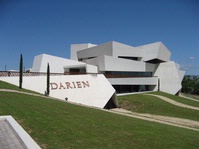 The region is obviously quite prosperous, and a construction boom has now provided a fascinating contrast between quaint medieval towns and strikingly modern, architecturally daring bodegas. Rioja is also within easy reach of bustling, beautiful Bilbao (with its gorgeous Guggenheim museum designed by Frank Gehry) as well as San Sebastian, which is one of Spain's most beautiful cities and a culinary destination of the first order.
The region is obviously quite prosperous, and a construction boom has now provided a fascinating contrast between quaint medieval towns and strikingly modern, architecturally daring bodegas. Rioja is also within easy reach of bustling, beautiful Bilbao (with its gorgeous Guggenheim museum designed by Frank Gehry) as well as San Sebastian, which is one of Spain's most beautiful cities and a culinary destination of the first order.
A last consideration leading me to believe that Rioja is about to re-assert itself with a vengeance is a calendar coincidence which will now enable it to send three great vintages onto world markets at once. Barrel- and bottle-ageing regulations set for wines in the Crianza, Reserva and Gran Reserva categories space out release dates over time. This year will see the release of Crianzas from 2005, Reservas from 2004 and Gran Reservas from 2001--three excellent vintages according Rioja's ratings by the Consejo Regulador (and my palate experience). This is the first time since the Consejo began rating vintages in 1928 that three excellent growing seasons have occurred in such close proximity, and of course it is also the first time that three excellent Rioja vintages will hit the street at the same time.
So watch out. Rioja has set a lot of things right, and is coming back--big time.
Questions? Comments? Write to me at mfranz@winereviewonline.com